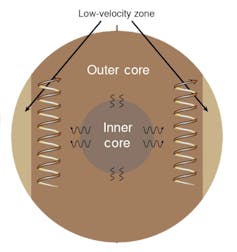About 2,890 kilometres beneath our ft lies a big ball of liquid steel: our planet’s core. Scientists like me use the seismic waves created by earthquakes as a sort of ultrasound to “see” the form and construction of the core.
Utilizing a brand new approach of learning these waves, my colleague Xiaolong Ma and I’ve made a stunning discovery: there’s a massive donut-shaped area of the core across the Equator, a couple of hundred kilometres thick, the place seismic waves journey about 2% slower than in the remainder of the core.
We predict this area comprises extra lighter parts comparable to silicon and oxygen, and will play an important position within the huge currents of liquid steel working by means of the core that generate Earth’s magnetic area. Our outcomes are revealed immediately in Science Advances.
The ‘coda-correlation wavefield’
Most research of the seismic waves created by earthquakes have a look at the large, preliminary wavefronts that journey all over the world within the hour or so after the quake.
We realised we might study one thing new by wanting on the later, fainter a part of these waves, referred to as the coda – the part that brings a chunk of music to its finish. Specifically, we checked out how related the coda recorded at completely different seismic detectors had been, a number of hours after they started.
In mathematical phrases, this similarity is measured by one thing known as correlation. Collectively, we name these similarities within the late components of earthquake waves the “coda-correlation wavefield”.
By wanting on the coda-correlation wavefield, we detected tiny alerts stemming from a number of reverberating waves we would not in any other case see. By understanding the paths these reverberating waves had taken and matching them with alerts within the coda-correlation wavefield, we labored out how lengthy that they had taken to journey by means of the planet.
We then in contrast what we noticed in seismic detectors nearer to the poles with outcomes from nearer the Equator. General, the waves detected nearer to the poles had been travelling sooner than these close to the Equator.
We tried out many laptop fashions and simulations of what circumstances within the core might create these outcomes. In the long run, we discovered there should be a torus – a donut-shaped area – within the outer core across the Equator, the place waves journey extra slowly.
Seismologists haven’t detected this area earlier than. Nevertheless, utilizing the coda-correlation wavefield lets us “see” the outer core in additional element, and extra evenly.
Earlier research concluded that waves moved extra slowly in all places across the “ceiling” of the outer core. Nevertheless, we have now proven on this examine that the low-velocity area is simply close to the Equator.
The outer core and the geodynamo
Earth’s outer core has a radius of round 3,480km, which makes it barely greater than the planet Mars. It consists primarily of iron and nickel, with some traces of lighter parts comparable to silicon, oxygen, sulfur, hydrogen and carbon.
The underside of the outer core is hotter than the highest, and the temperature distinction makes the liquid steel transfer like water in a pot boiling on the range. This course of is named thermal convection, and we expect the fixed motion ought to imply all the fabric within the outer core is sort of effectively blended and uniform.
But when in all places within the outer core is stuffed with the identical materials, seismic waves ought to journey at about the identical velocity in all places, too. So why do these waves decelerate within the donut-shaped area we discovered?
We predict there should be the next focus of sunshine parts on this area. These could also be launched from Earth’s stable internal core into the outer core, the place their buoyancy creates extra convection.
Why do the lighter parts construct up extra within the equatorial donut area? Scientists assume this might be defined if extra warmth is transferred from the outer core to the rocky mantle above it on this area.

There may be additionally one other planetary-scale course of at work within the outer core. Earth’s rotation and the small stable internal core make the liquid of the outer core organise itself in lengthy vertical vortices working in a north–south course, like large waterspouts.
The turbulent motion of liquid steel in these vortices creates the “geodynamo” accountable for creating and sustaining Earth’s magnetic area. This magnetic area shields the planet from dangerous photo voltaic wind and radiation, making life attainable on the floor.
A extra detailed view of the make-up of the outer core – together with the new-found donut of lighter parts – will assist us higher perceive Earth’s magnetic area. Specifically, how the sector modifications its depth and course in time is essential for all times on Earth and the potential habitability of planets and exoplanets.![]()
Hrvoje Tkalčić, Professor, Head of Geophysics, Director of Warramunga Array, Australian Nationwide College
This text is republished from The Dialog beneath a Artistic Commons license. Learn the authentic article.





